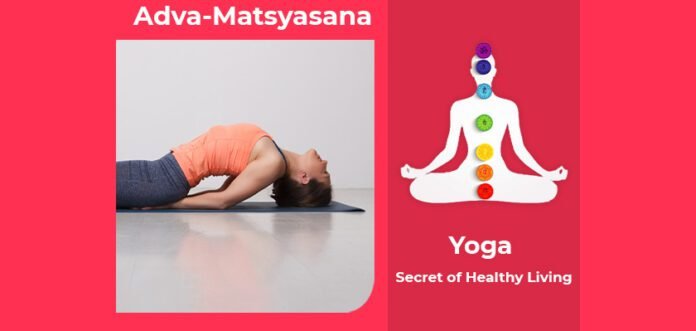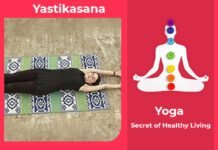What is Adva Matsyasana
Adva Matsyasana In this asana posture the shape of the body appears similar to fish in the water.In this asana, one can float on the water without any movement in this asana.
Also Know as: Prone Fish Posture/ Pose, Adho Matsya Asana, Adha Matsy Asan
How to start this Asana
- Lie down on the ground on your back in shavasana .
- Now, keep your buttocks on the floor, inhale and raise the head, shoulder, back and the upper arms off the floor arching the back and raising the chest up.
- Tilt your head back and place the top of the head flat on the ground.
- Now, raise your elbows off the floor and bring your hands up just below your chest and join them at the palms with the fingers pointing straight up (or we can say, in Anjali mudra).
- Then breathe gently through the nostrils to remain longer in the pose.
How to end this Asana
- When you think it’s enough for you or you feel tired then come back to shavasana.
Video Tutorial
Benefits of Adva Matsyasana
According to research, this Asana is helpful as per below(YR/1)
- This asana increases the size of the rib cage.
- Make the neck flexible and strong.
- It widens the wind pipe and thus helps deep breathing.
- Good effects on the facial tissue.
- Correct the disorders of the spine.
Precaution to be taken before doing Adva Matsyasana
As per several scientific studies, precautions need to be taken in diseases mentioned as per below(YR/2)
- This asana can also be tried with padamasana but the beginners should not do this with padamasana because first one will be easier for the beginners.
- The persons who have migraine, high or low blood pressure and serious neck or back injury.
So, consult your doctor if you have any of the problem mentioned above.
Histroy and scientific base of Yoga
Due to the oral transmission of sacred writings and the secrecy of its teachings, yoga’s past is riddled with mystery and confusion. Early yoga literature were recorded on delicate palm leaves. So it was easily damaged, destroyed, or lost. Yoga’s origins may be dated back over 5,000 years. However other academics believe it could be as old as 10,000 years. Yoga’s lengthy and illustrious history may be split into four distinct periods of growth, practise, and invention.
- Pre Classical Yoga
- Classical Yoga
- Post Classical Yoga
- Modern Yoga
Yoga is a psychological science with philosophical overtones. Patanjali begins his Yoga method by instructing that the mind must be regulated – Yogahs-chitta-vritti-nirodhah. Patanjali does not delve into the intellectual underpinnings of the need to regulate one’s mind, which are found in Samkhya and Vedanta. Yoga, he continues, is the regulation of the mind, the constraint of the thought-stuff. Yoga is a science based on personal experience. The most essential advantage of yoga is that it helps us to maintain a healthy bodily and mental state.
Yoga can help to slow down the ageing process. Since aging starts mostly by autointoxication or self-poisoning. So, we can considerably limit the catabolic process of cell degeneration by keeping the body clean, flexible, and properly lubricated. Yogasanas, pranayama, and meditation must all be combined to reap the full advantages of yoga.
SUMMARY
Adva Matsyasana is helpful in increase flexibility of muscles, improves shape of the body, reduce mental stress, as well improves overall health.




